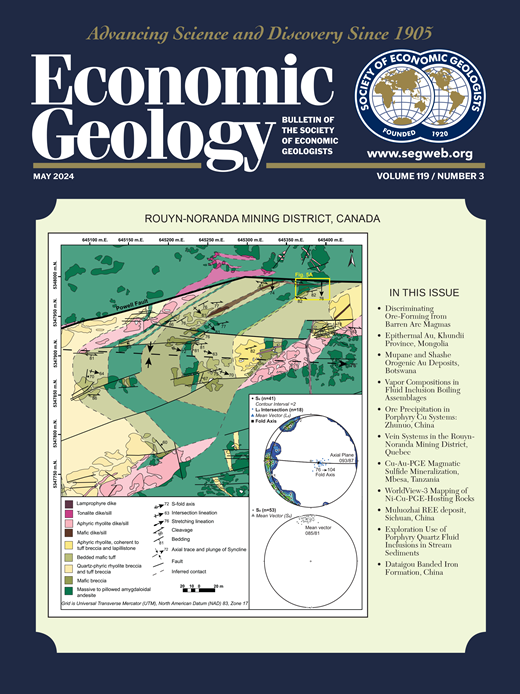Variable Partitioning of Lithium in Rhyolitic Melt During Decompression and Ascent
IF 4.9
1区 地球科学
Q1 GEOCHEMISTRY & GEOPHYSICS
引用次数: 0
Abstract
The partitioning behavior of Li in magmatic systems is increasingly being investigated due to the economic importance of Li in the transition to sustainable energy resources (e.g., batteries). However, at upper crustal pressures, it remains uncertain whether Li preferentially partitions into the vapor or liquid (brine) phase or remains in the silicate melt. This complicates our ability to determine where Li resides—silicate melt, minerals, or fluid phase—upon eruption, a crucial factor for understanding its postdepositional movement and concentration into a brine or volcano-sedimentary deposit. Here, we present a novel investigation into the behavior of Li within natural evolved melts during continuous magma decompression and ascent using melt embayments (open melt inclusions). Mineral-hosted melt embayments preserve records of the evolving composition of the exterior melt, including degassing pathways and ascent timescales, when paired with appropriate diffusion coefficients. Lithium concentration profiles were measured in quartz-hosted melt embayments from the rapidly quenched eruptive phases of five rhyolitic, caldera-forming eruptions to investigate the behavior of Li during magma decompression and ascent, where vapor partitioning and ascent dynamics were previously established by investigating H2O and CO2 profiles. We find that in four systems, embayments contain lower interior Li concentrations than the coerupted melt inclusions; the fifth system contains the same Li concentrations in embayments and melt inclusions. However, many of these embayments contain gradients, with 84% preserving Li enrichment near the melt-bubble interface, as compared to their interior concentration. We interpret these characteristics to represent two distinct stages of Li partitioning during magma decompression and ascent, in contrast to existing literature that proposes only one type of partitioning behavior. The first stage is interpreted as melt depletion of Li, likely driven by partitioning into an exsolved supercritical fluid phase, supported by the strong correlation between the extent of Li depletion and Cl concentration in the melt, as well as the decompression rate. This behavior then fundamentally shifts, where Li reenriches in the melt, postulated to be driven by the unmixing of the supercritical fluid phase at shallow pressures. For the one system that did not develop Li gradients through decompression, we attribute this to the lower values of Na and Cl in the melt, potentially inhibiting the partitioning of Li into a fluid phase. Importantly, the behavior of Li during decompression is not consistent within or between volcanic centers, highlighting the need for systematic experimental investigation in variable composition melts at pressures relevant to conduit dynamics. This knowledge would improve our ability to model Li profiles to understand magma decompression, and predict where Li resides (e.g., stored in volcanic glass, gas, or crystals) upon eruption prior to any later extraction.流纹岩熔体在减压和上升过程中锂的可变分配
由于锂在向可持续能源(如电池)过渡中的经济重要性,锂在岩浆系统中的分配行为正越来越多地被研究。然而,在上地壳压力下,尚不确定Li是否优先分配到蒸汽或液体(盐水)相或留在硅酸盐熔体中。这使我们确定Li在喷发时的位置——硅酸盐熔体、矿物或流体阶段——的能力变得复杂,而这是了解其沉积后运动和浓缩成盐水或火山沉积矿床的关键因素。在这里,我们提出了一种新的研究方法,利用熔体嵌入(开放熔体包裹体)来研究连续岩浆减压和上升过程中自然演化熔体中Li的行为。当与适当的扩散系数配对时,含矿物的熔体遗址保存了外部熔体演化组成的记录,包括脱气路径和上升时间尺度。研究人员测量了5次流纹岩、破火山口形成喷发的快速淬灭阶段的石英熔融体中锂的浓度分布,以研究Li在岩浆减压和上升过程中的行为,此前通过研究H2O和CO2分布建立了蒸汽分配和上升动力学。研究发现,在4个体系中,嵌套体内部Li浓度均低于共喷发熔体包裹体;第5个体系中嵌套和熔融包裹体中含有相同浓度的锂。然而,与内部浓度相比,这些沉积物中有84%在熔泡界面附近保留了Li富集。我们将这些特征解释为岩浆减压和上升过程中Li划分的两个不同阶段,而不是现有文献只提出一种类型的划分行为。第一阶段被解释为熔体中Li的耗尽,可能是由分解成一个脱溶的超临界流体相驱动的,Li的耗尽程度与熔体中Cl浓度以及减压速率之间的强相关性支持了这一阶段。然后,这种行为从根本上发生了变化,Li在熔体中重新富集,假定这是由超临界流体相在浅压力下的解混驱动的。对于一个没有通过减压形成Li梯度的体系,我们将其归因于熔体中Na和Cl的较低值,这可能抑制了Li向流体相的分配。重要的是,减压过程中Li的行为在火山中心内部或火山中心之间是不一致的,这突出了在与管道动力学相关的压力下对变成分熔体进行系统实验研究的必要性。这些知识将提高我们模拟Li剖面的能力,以了解岩浆减压,并在喷发前预测Li的位置(例如,储存在火山玻璃、气体或晶体中)。
本文章由计算机程序翻译,如有差异,请以英文原文为准。
求助全文
约1分钟内获得全文
求助全文
来源期刊

Economic Geology
地学-地球化学与地球物理
CiteScore
10.00
自引率
6.90%
发文量
120
审稿时长
6 months
期刊介绍:
The journal, now published semi-quarterly, was first published in 1905 by the Economic Geology Publishing Company (PUBCO), a not-for-profit company established for the purpose of publishing a periodical devoted to economic geology. On the founding of SEG in 1920, a cooperative arrangement between PUBCO and SEG made the journal the official organ of the Society, and PUBCO agreed to carry the Society''s name on the front cover under the heading "Bulletin of the Society of Economic Geologists". PUBCO and SEG continued to operate as cooperating but separate entities until 2001, when the Board of Directors of PUBCO and the Council of SEG, by unanimous consent, approved a formal agreement of merger. The former activities of the PUBCO Board of Directors are now carried out by a Publications Board, a new self-governing unit within SEG.
 求助内容:
求助内容: 应助结果提醒方式:
应助结果提醒方式:


